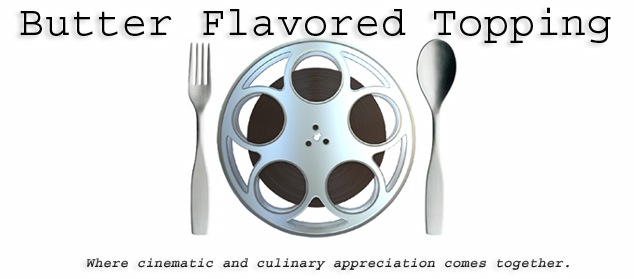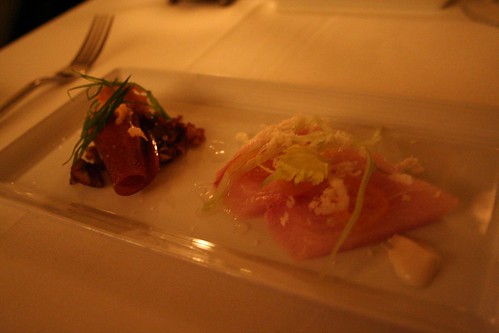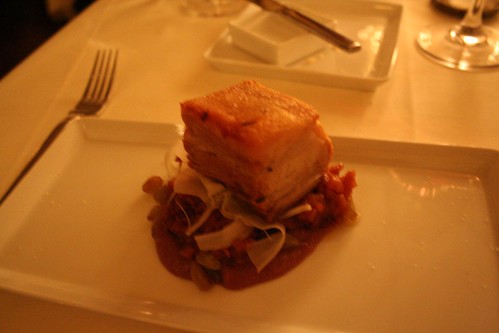 All war pictures invariably ask at some point if the mission -- and by extension, the war -- is worth it. John Frankenheimer’s 1964 film The Train asks this question in a simple, yet provocative way. In the film, a French rail station manager played by the outrageously swarthy American Burt Lancaster tries to stop a train carrying priceless works of French art from Paris into Germany.
All war pictures invariably ask at some point if the mission -- and by extension, the war -- is worth it. John Frankenheimer’s 1964 film The Train asks this question in a simple, yet provocative way. In the film, a French rail station manager played by the outrageously swarthy American Burt Lancaster tries to stop a train carrying priceless works of French art from Paris into Germany.
It’s a terrific conceit that leaves aside the standard cliches of war adventures. There is no bond of brotherhood between soldiers here, or subplots involving broken loyalties, or the glory of battle. There are paintings by Renoir, Degas, Cezanne, Picasso, and Matisse. There is Col. Von Waldheim, a ruthless German officer who appreciates them, and Labiche, the gruff, no nonsense member of the underground who does not. When the museum curator informs Labiche of Von Waldheim’s plan, he bluntly points out how he’s running low on men and asks if she has copies of the paintings. When told that the fallen members of the underground would’ve wanted to save the art, he responds, “And they're dead. And they'll never know!”
There’s lots of nifty action, with trains derailing and colliding and whistling and squealing, all of which is a childhood dream come true for any outrageously swarthy dude who ever had a train set. In one scene, Lancaster slides down a ladder, gets up a head of steam, and jumps aboard a passing train -- all in one shot by Frankenheimer.
It’s a lean and mean affair that unfolds like one long shell game, with Labiche and his cohorts trying to trick the German officers onboard that the train is en route to Germany when, in fact, it is looping back toward Paris. I enjoyed the tricks the French Underground employed to fool the German officers, and the numerous, sometimes ingenious ways Frankenheimer finds to make a train running along tracks exciting. At one point, Labiche must bring an engine from one station to another in broad daylight, and he soon comes under fire from a British fighter that, of course, does not know a swarthy American playing a French saboteur is at the helm. The ensuing scene becomes a race to a tunnel, with Labiche getting the engine up to top speed and then having to slam on the brakes to avoid being strafed.
Another twist involves Labiche’s having to paint the roof of the train so that future Allied air attacks can identify it and let it be. While the bulk of the film focuses on these and other tactics, what really grounds the action is the constant question: is it worth it? The more Col. Von Waldheim is undermined, the more vicious he becomes. At several points, dozens of civilians are lined up and shot without hesitation. Von Waldheim is a terrific villain, a ruthless man of culture who is a great foil to Labiche. At one point he tells Labiche, “The paintings are mine; they always will be; beauty belongs to the man who can appreciate it.”
The film succeeds because it balances the swift action and clockwork plotting with these brief exchanges about the value of art and culture. “This is our pride, what we create and hold for the world. There are worse things to risk your life for than that” argues the museum curator early in the film. Labiche says he can’t help her, but he does. Because that’s what swarthy dudes do during war.
22 April 2009
The Train (1964)
19 December 2008
The Foundry + Sprinkles
Last Sunday was my birthday. Considering I am still recovering from my wedding three weeks earlier (hence this being the first BFT post in 5+ months -- w00t!), I decided on a low-key affair consisting of: sleeping in, coffee infused with a cinnamon stick (inspired by Mexico honeymoon), passively watching football while tooling around on my new MacBook Pro, and finally getting up in the afternoon to hit up two Los Angeles spots I've heard much about.
Finely crafted. Gorgeous. Flavorful. We stuffed ourselves on four courses.
She says: "Fabulous. Phresh with a P-H. I really liked the salt on the yellowtail with the celery and the citrus." Note the tartare rolled up inside a date.
They bring out the dish with the bread pudding, bacon, and egg by itself. Then they pour the soup right in front of you. The soup was flavorful without being too heavy. And I'm a big believer in topping anything and everything with a fried egg. When you think about it, it's like a classic diner breakfast in soup form. Except really elegant. The bread putting puts it over the top. Lots of different textures going on.

She says: "The best thing there." I had a bite. Twas most cheesy, in a good way.
Somewhat similar to one of my favorite Filipino dishes, lechon kawali. Which is exactly why I ordered it. It didn't disappoint. The pork belly was perfectly cooked, with crispy skin/fat that wasn't oily in the slightest, plus really tender and juicy meat. Camille suspects that, instead of deep frying it, they probably ladled hot oil to crisp it. The salty/crispy of the pork on top of the rich sweetness of the yam was delightful.
She says: "Cooked perfectly. But it was 'eh.' Something you can get at any restaurant."
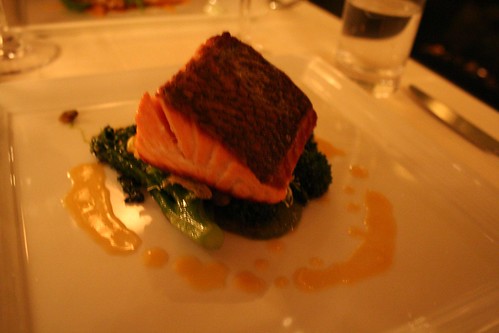
I was surprised they gave me two duck legs. At this point, after potato soup and pork belly, I was beginning to fill up. Crispy and juicy in all the right spots. I don't know what kind of salt is used, but it brings a subtle yet distinct layer of flavor to the duck. The fixings were fine, but not the melding of flavors that my previous courses had.
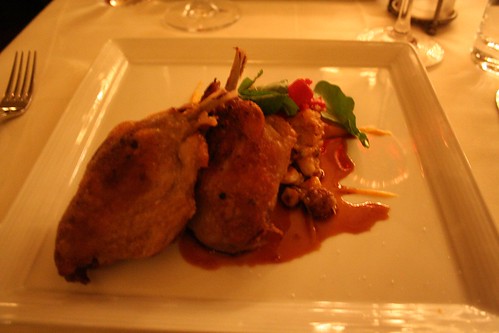
At this point we were about to explode. I didn't mention that between each course, a small bread was served. No more than two bites apiece, but we're four courses in, now. Woof. I really liked the addition of the fruit and especially the orange sherbert. The citrus helps cut through the richness and sweetness of the creme brulee. I wanted the sugar coating to have a more distinctive crunch... you know, the whole brulee bit. In fairness, I was done before this thing hit the table. Lots. Of. Food.

We didn't actually get a shot of frosting, but the cupcakes were good. Firm and moist and sweet and all that stuff. They do a cream cheese frosting that's very nice. The red velvet cupcakes are one of their most popular, and for good reason. Even though I was stuffed, I plowed through one when we'd returned home. Most satisfying.
Labels: American, dinner, duck, Filipino, food, Los Angeles, pork, restaurants, romance, soup
10 July 2008
The Incredible Hulk
 ...not to be confused with Ang Lee's 2003 Hulk, which was less incredible and more sleep-inducing. 2008's The Incredible Hulk is a kinda, sorta sequel and kinda, sorta reboot of the franchise starring Edward Norton in a soft-spoken, nuanced performance. I was surprised by how the story unfolded early on, with Bruce Banner in hiding and trying to deal with the menace he's already been saddled with (the opening credits remind you of his radioactive incident, of course). When Norton isn't the Hulk, many of his scenes are told with simple looks. Norton carries a good chunk of the film with his eyes, which for the most part are sad and forlorn. Though he's done quite a few flicks since, my last impression of him was his mail-it-in performace in The Italian Job, so it's good to see him back to form.
...not to be confused with Ang Lee's 2003 Hulk, which was less incredible and more sleep-inducing. 2008's The Incredible Hulk is a kinda, sorta sequel and kinda, sorta reboot of the franchise starring Edward Norton in a soft-spoken, nuanced performance. I was surprised by how the story unfolded early on, with Bruce Banner in hiding and trying to deal with the menace he's already been saddled with (the opening credits remind you of his radioactive incident, of course). When Norton isn't the Hulk, many of his scenes are told with simple looks. Norton carries a good chunk of the film with his eyes, which for the most part are sad and forlorn. Though he's done quite a few flicks since, my last impression of him was his mail-it-in performace in The Italian Job, so it's good to see him back to form.
The film as a whole is solid if unspectacular. I liked the patience of the opening sequences, how the film takes its time establishing Banner's fugitive life in Brazil (which, incidentally, looks georgeous). This is, after all, a character who's established goal is to NOT get angry and turn into the titular character, and I liked how Banner was constantly monitoring his pulse and teaching himself to channel his energy while on his search for a cure.
I was also pleasantly surprised by director Louis Leterrier. I've liked the Luc Besson disciple's previous work, especially the Jet Li flick Unleasehed, but Transporter 2 isn't exactly a hallmark of cinema (I still like it, though). I watched Incredible Hulk a day after taking in the flashy and hollow Wanted, and Leterrier is clearly comfortable balancing character and action moments. The first big action scene in the Brazilian cola bottling factory is an impressive example of pacing, editing, and building tension, with the Hulk emerging from shadow only as a brief silohuette from a flash grenade. It's a geeky, uber-cool moment of iconography, a payoff for the film's quiet opening passages.
Unfortunately, as tuned in to the character as the screenplay is, the plot plods along from one locale to the next without any real sense of urgency. The insinuation the entire film is General Ross (William Hurt) needs to cover up this insidious military experiment gone awry while also restarting the project in secret... which explains the small, specialist squad led by Emil Blonksy (Tim Roth) but not the tanks and helicopters that come storming onto an American university -- tanks and helicopters being difficult to explain when one wants to keep a conspiracy on the down low. There's a sweet subplot with Betty Ross (Liv Tyler) helping Bruce evade her father, but the further along the story progresses, the less clear and more obligatory things become.
I liked the mini-rivalry Hulk has with Blonksy, a warrior who yearns to combine his experience with an all-powerful body of his own, but the finale feels like a long, drawn-out sideshow. There's a moment late in the film where a crowd of people -- including the Rosses -- watch the heroic Hulk walk away, and I wasn't sure if they were happy about this or not. It's a frustrating climax that not only leaves questions unanswered (sequel!) but raises questions and reveals plot holes that otherwise would have gone cheerfully unnoticed.
What the film lacks is that extra gear that all good action movies have. While I appreciated the simplicity of the film's opening, the ending is overly simplistic, leaning on gravitas that isn't really there. The film is executed well, but at the end of the day, it's a one-note story.
Labels: action, drama, film, film/TV review
Wanted
 Your reaction to Wanted will depend largely on how you handle the Loom of Destiny. It's a machine at the center of the Wanted universe and a big linchpin in the plot. It tells the Fraternity, the society of assassins in the story, who to kill next via irregularities in the stitching that are actually coded messages.
Your reaction to Wanted will depend largely on how you handle the Loom of Destiny. It's a machine at the center of the Wanted universe and a big linchpin in the plot. It tells the Fraternity, the society of assassins in the story, who to kill next via irregularities in the stitching that are actually coded messages.
If you're confused, yes, it's that kind of loom. A machine that weaves yarn into cloth. This is an action movie about a millenia-old underground society of superhuman killers who restore balance to the world based on the machinations of a device that makes sweaters.
If you can buy that, you're going to love Wanted. Me, not so much.
I had mixed expectations about the film going in. The imagery left me cold, but then the reviews starting pouring in and praising director Timur Bekmambetov for his inventiveness and flair. Apparently, he was given an uncanny amount of freedom, especially for a foreign director making his English-language debut with a big budget Summer flick. And at one point during the film, I thought to myself that Bekmambetov was Michael Bay with a sense of restraint. He has a feeling for when to let a scene breathe versus when to go for the craziness. The first big action sequence specifically is full of energy and excitement, what with a confused Wesley (James McAvoy) being literally swept away at 100 mph by Fox (Angelina Jolie -- really, that's her character name) and her Dodge Viper. Jolie proceeds to lie on the car's hood so she can steer with her feet and shoot backwards at the bad guy. The sequence has a visceral quality that all great action sequences should have -- speed, momentum, a sense of danger.
And then in comes the Loom of Destiny. Which, again, is a machine that weaves yarn.
There's something so obligatory, so plain, so by-the-numbers about Wanted's storyline that keeps Bekmambetov's visual flair from succeeding. The screenplay pretends to be about Wesley's search for an identity, a search ignited by the revelation that his father was the world's best assassin, but all we get is a lackadaisical training montage highlighted by pretty CGI bullets dancing through the air in slow motion. The story then throws away all established themes and logic for the sake of plot twists that are supposed to be eye-opening, but are instead confounding and empty. Basically, the film tramples all over its first half in order to fill the second half with twists that lack sense. Wesley supposedly is following in his father's footsteps, but the film is too busy to note how he feels about this, instead giving us cryptic backstory for Fox and underwhelming lectures about the Fraternity's role in the world. At the center of it all is an air of myth and mysticism in the form of a machine that turns cotton into tablecloths.
For all the spectacular, inventive action, there's just as much that is hollow and superficial. Much is made of the bullet bending trick, especially for what it represents about Wesley's growth, but then that's that, and the plot keeps chugging along. Visually, there's something anti-climactic about watching two bullets slam into each other. Even the big finale is a letdown, involving an overly-elaborate scheme with bombs planted onto rats. I'm not sure if this strategy is supposed make Wesley clever or not, but all it basically accomplishes is to open the front door for him. Speed? Momentum? A sense of danger? No, no... we get bomber rats.
Wanted puts the fate of its characters, plot, and themes in the hands of the Loom of Destiny. The actors acquit themselves well enough, and some of the action is pretty cool, but at the end of the day, things hinge on a machine that knits. Who know who else knits? My mom.
Labels: action, drama, film, film/TV review
19 June 2008
Maui, Part 2: Going Native
Read Maui, Part 1
Before coming to Maui, the only agricultural product I associated with the island was the Maui onion. And then only because they make Maui Style onion-flavored potato chips. When I say "they make," I am referring to the Frito-Lay division of PepsiCo. in Plano, Texas. (If you want to find any of their "Hometown Favorites" products, use their nifty item locator.) According to the ingredients list, there is indeed some Maui onion powder in the Maui Onion-flavored chips. It's the 13th of 15th ingredient listed, ahead of Hydrolyzed Proteins and Caramel Color, but behind Corn Maltodextrin, Monosodium Glutamate, Malic Acid, and that classic and most sacred of culinary components, "Natural Flavor."
I don't necessarily have a problem with eating mass-processed junk food. After all, Camille and I stayed in early on our first night, our jet lag-induced slumber interrupted by a dinner that consisted of a bag of Natural Flavor and Maui Onion Powder. But there is something to eating fresh and local, as I found out.
Of course, this is the tourist's dilemna: to find that definitively, quintessentially local thing before it gets dolled up, appropriated, outsourced, and repackaged as Totally Local, Brah! Some recreations are worthwhile (like, say, a luau), but others, not so much (floral golf ball 3-pack). What I'll take away the most from Maui is a sense of what it truly means to go local, at least as far as food is concerned. Nevermind where the purveyors, chefs, and waiters came from. Much of the best stuff Camille and I ate was from the land and waters of Maui.
Imagine that, eating food before it gets packed and shipped off to Plano.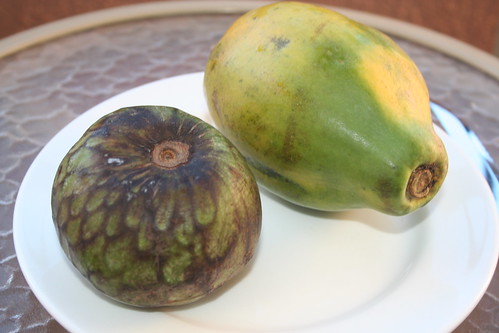
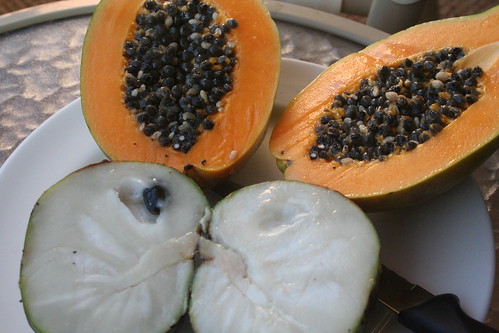 I was never really a farmer's market guy before. I simply didn't understand the difference between what Albertson's, Ralph's, and Von's featured in their produce section versus stuff that had not traveled thousands of miles. Before our trip to Hawaii, I had some gnarly peaches and pears that came from my local Los Angeles Albertson's via Chile. Certainly, I've had perfectly decent fruit from faraway lands before, but it's easy to accept "pretty good" when you haven't had "frakking fantastic" on a semi-normal basis. It helps when that frakking fantastic fruit is exotic and tropical, as with the cherimoya and papaya we procured from the weekly Maui Swap Meet. (Also picked up some cool and, yes, local t-shirts.)
I was never really a farmer's market guy before. I simply didn't understand the difference between what Albertson's, Ralph's, and Von's featured in their produce section versus stuff that had not traveled thousands of miles. Before our trip to Hawaii, I had some gnarly peaches and pears that came from my local Los Angeles Albertson's via Chile. Certainly, I've had perfectly decent fruit from faraway lands before, but it's easy to accept "pretty good" when you haven't had "frakking fantastic" on a semi-normal basis. It helps when that frakking fantastic fruit is exotic and tropical, as with the cherimoya and papaya we procured from the weekly Maui Swap Meet. (Also picked up some cool and, yes, local t-shirts.)
I'd never even heard of a cherimoya before this trip. It's a custard apple with a sweet, semi-pungent smell, and soft, sweet, white flesh that truly has the texture of soft custard. I spent the entire trip in Maui hoping to get a taste of fresh passion fruit, but the cherimoya sated my exotic fruit desires. Frankly, it's the damnedest thing I've ever eaten. It's Jell-o grown by a tree. And you know what they say about Jell-o.
By the way, you can thank Google for Calimoya, a cherimoya, passion fruit, avocado, and dragon fruit grower in the Santa Barbara area. Expensive, but will ship 2-day UPS when the fruits are in season. Have I overused the phrase "frakking fantastic" yet? One of the most popular ways to take in the local scenery of Maui is to drive the road to Hana, a twisting road along Maui's eastern coast that includes lots of lush greenery, hiking trails, waterfalls, and fruit stands that operate on the honor system. Sadly, I did not snap a picture of one of these fruit stands that consist simply of a shelf or two of produce, a menu listing prices, and a lock box with a slot for money. The best spur-of-the-moment purchase on the trip was at the Halfway to Hana stand (which also contained people -- boo), where we'd stopped for their much-lauded banana bread. A free sampling of toasted coconut was placed in front of me as my purchase was rung up. I'm not a huge coconut fan, especially dried coconut, but this stuff was something else. The perfect balance of that nutty coconut flavor with (light brown?) sugar. The banana bread was really good, but this sweetened toasted coconut stuff alone was worth half the trip to Hana.
One of the most popular ways to take in the local scenery of Maui is to drive the road to Hana, a twisting road along Maui's eastern coast that includes lots of lush greenery, hiking trails, waterfalls, and fruit stands that operate on the honor system. Sadly, I did not snap a picture of one of these fruit stands that consist simply of a shelf or two of produce, a menu listing prices, and a lock box with a slot for money. The best spur-of-the-moment purchase on the trip was at the Halfway to Hana stand (which also contained people -- boo), where we'd stopped for their much-lauded banana bread. A free sampling of toasted coconut was placed in front of me as my purchase was rung up. I'm not a huge coconut fan, especially dried coconut, but this stuff was something else. The perfect balance of that nutty coconut flavor with (light brown?) sugar. The banana bread was really good, but this sweetened toasted coconut stuff alone was worth half the trip to Hana.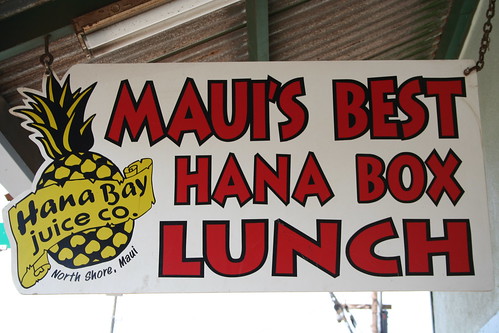 However, unless you're satisfied grazing on mysteriously orphaned fruit at a fruit stand, you'll want to grab a picnic lunch before embarking on the Hana trip. We hit up the Hana Bay Juice Co. in Paia, which has scrumptious sandwiches and really tasty smoothies. They even offer coolers and ice packs. What I remember most about the sandwiches other than them tasting really good was the bread. Sure, I suppose eating a sandwich on a beautiful peninsula in paradise helps, but all the great sandwiches that stick out in my mind have had one thing in common: perfect bread that's crunchy on the outside, soft and moist on the inside, and holds up to the rigors of sandwich eating without spilling its innards everywhere. Camille had a smoked salmon sandwich with cream cheese and capers. I had roast beef. Good ingredients all around, but again, when it comes to sandwiches, it's all about the bread.
However, unless you're satisfied grazing on mysteriously orphaned fruit at a fruit stand, you'll want to grab a picnic lunch before embarking on the Hana trip. We hit up the Hana Bay Juice Co. in Paia, which has scrumptious sandwiches and really tasty smoothies. They even offer coolers and ice packs. What I remember most about the sandwiches other than them tasting really good was the bread. Sure, I suppose eating a sandwich on a beautiful peninsula in paradise helps, but all the great sandwiches that stick out in my mind have had one thing in common: perfect bread that's crunchy on the outside, soft and moist on the inside, and holds up to the rigors of sandwich eating without spilling its innards everywhere. Camille had a smoked salmon sandwich with cream cheese and capers. I had roast beef. Good ingredients all around, but again, when it comes to sandwiches, it's all about the bread.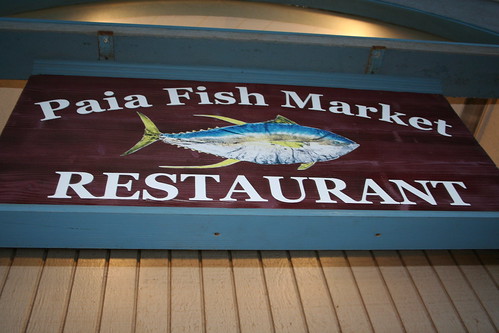 Returning from Hana, we stopped in Paia again to eat at Paia Fish Market. It's a casual, lively place that features some strong European accents from both customers and employees. The vibe is that of a quaint, all-night diner, with the cook having to shout order numbers over the loud din of conversation at shared tables.
Returning from Hana, we stopped in Paia again to eat at Paia Fish Market. It's a casual, lively place that features some strong European accents from both customers and employees. The vibe is that of a quaint, all-night diner, with the cook having to shout order numbers over the loud din of conversation at shared tables.
In terms of their food, they feature a lot of fresh and tasty fish. I had ono tacos. The slaw of roughage in the tacos was, as you can see, a little overwhelming, but it was all good. A fine, messy meal. Bonus points for heating the tortilla so it was slightly crunchy. Camille's opah sauteed in butter, white wine, lemon, and garlic was good if a tad too well done. (Fine woman that she is, she chose the meaty opah in anticipation that it'd be overcooked, knowing it'd retain some moistness.) 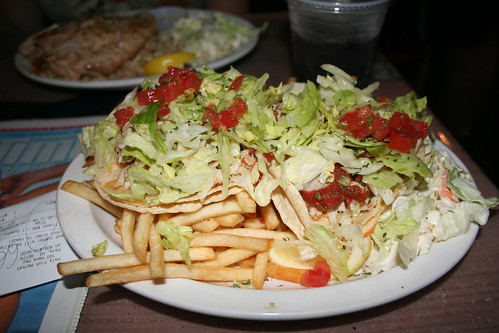
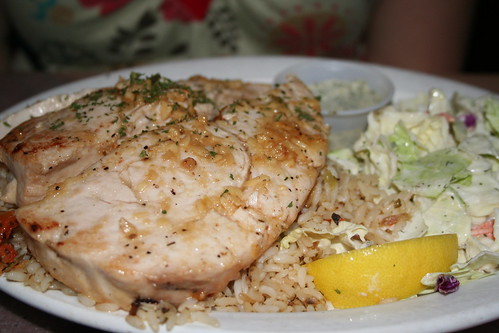 Okay, so ono fish tacos aren't quintessentially Hawaiian. And God knows who was the first to saute fish in garlic, butter, white wine, and lemon. But there isn't easy access to stuff like this in Los Angeles, so, in my mind, it's explicitly local to these islands. (Nevermind the fries and rice accompanying our dishes.)
Okay, so ono fish tacos aren't quintessentially Hawaiian. And God knows who was the first to saute fish in garlic, butter, white wine, and lemon. But there isn't easy access to stuff like this in Los Angeles, so, in my mind, it's explicitly local to these islands. (Nevermind the fries and rice accompanying our dishes.)
No, the truly local part of our trip didn't begin until our tours into Kula.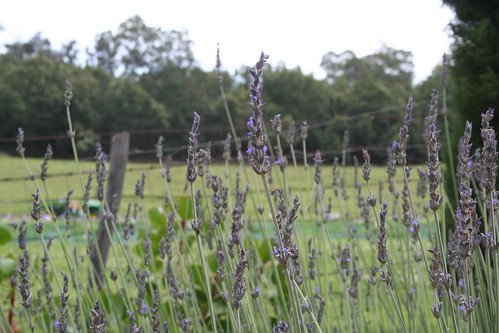 The Ali'i Kula Lavender Farm is a nifty place to start. (Or the 'AKL.' Not to be confused with the ATL.) Incidentally, Ali'i is a Hawaiian term for royalty or noble class. And the dude who started the farm goes by the name of Ali'i. Seriously, who names their kid "royalty?" Other than Michael Jackson? Moving on...
The Ali'i Kula Lavender Farm is a nifty place to start. (Or the 'AKL.' Not to be confused with the ATL.) Incidentally, Ali'i is a Hawaiian term for royalty or noble class. And the dude who started the farm goes by the name of Ali'i. Seriously, who names their kid "royalty?" Other than Michael Jackson? Moving on...
The AKL is 10.5 acres of serene, manicured gardens containing something like a kajillion types of lavender. Tours range from the free, self-guided variety (highly recommended) to a $12, 30-minuted guided walk and, lastly, an exclusive golf cart tour with grower Alii Chang. This last one is limited to five people per day, and for $25 bucks you'll have a dude whose first name is literally royalty talk your head off about a kajillion types of lavender.
The place is beautiful, don't get me wrong. There's something kind of mystical about Kula, all the lush, green rural land halfway up the slopes of a dormant volcano, and this farm is a fine place to stop and take it all in. But you can certainly do it for free with one of their photocopied guides to lavender, which we did. Camille and I had fun eating lavender scones and drinking lavender tea on the AKL Farm's quaint patio after perusing the many lavender-infused items in the gift shop. I recently used some AKL Farm lavender pepper to coat the skin on some pan-roasted chicken and also on shrimp, and it was good stuff -- a wise investment.
As for the scones... well, okay, they taste like scones. The lavender flavor in them could easily by in my mind. No, a more palpable and enjoyable way to eat the scones is to slather them with lavender lilikoi jelly. It's more than a dollar per ounce and we bought two jars. Sweet, tangy, and fragrant, it made the scones a delectable experience. Washing it down with lavender tea, which certainly does not skimp on the lavender, made for a wonderfully calming afternoon.
Lavender, by the way, is native to the Mediterranean, not Hawai'i. Strictly speaking, next to nothing is native to Hawai'i except dried lava. But one of the fantastic things about Hawaii that's very evident in Maui -- and especially in Kula -- is the fertility of the land. I couldn't really tell you what a microclimate is (though I'd hazard a guess that it means "really small climate"), but they got 'em in spades in Maui. Which is a good thing for farmers.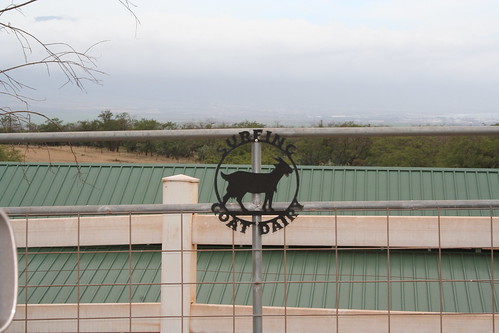 The Surfing Goat Dairy is a fun little diversion. It was founded by two German expatriates (seriously, what is it about Maui that attracts the Europeans?), but we were toured around by a kindly, portly, limping Polynesian lady wearing a muumuu. She reminded me of the cafe owner in 50 First Dates. Hopefully, no one has said this to her face, but hey, I don't have a lot of pop culture references for kindly, big-boned Polynesians.
The Surfing Goat Dairy is a fun little diversion. It was founded by two German expatriates (seriously, what is it about Maui that attracts the Europeans?), but we were toured around by a kindly, portly, limping Polynesian lady wearing a muumuu. She reminded me of the cafe owner in 50 First Dates. Hopefully, no one has said this to her face, but hey, I don't have a lot of pop culture references for kindly, big-boned Polynesians.
The tour is short and sweet: see milking equipment, see baby goats, see adult goats, see pot-bellied pig humping rocks, taste cheese. If we had the means to keep it cool, we would have definitely bought some cheese to bring home. Not to belabor the point, but all the cheese was super fresh, and in their relatively short time as a dairy, the Surfing Goat has certainly mastered ways to combine their creamy cheeses with some local flavors, like the lilikoi quark.
What I really liked more than anything else was realizing just how small an operation the Surfing Goat Dairy is. It really is just one family with a few hired hands, and in this day and age, it's admirable to see them pull that off. They even resist selling their older goats for meat, simply letting them retire to pasture for the rest of their natural lives. I have no idea if there are undiscovered local farms in the Los Angeles area, but I sure hope so, because it's something I'd definitely support.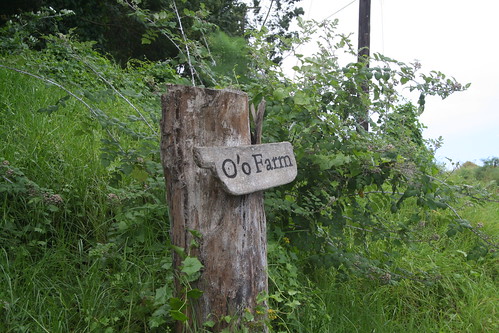 The lavender farm features a very specific food chain. If you're not interested in any type of lavender, much less countless variations of them, but you are interested in really good food and the food chain that supports it, then you owe it to yourself to take the tour and have lunch on the O'o Farm (which is literally down the road from the AKL). It's an organic farm growing much of the produce served at two of Maui's acclaimed, upscale restaurants, Pacific'O and I'O. They'll take you around and teach you about their organic practices, let you taste stuff straight out of the ground, and then serve you a lunch prepared almost entirely with ingredients they've grown (the exceptions being bread and fish, which cannot be grown in dirt).
The lavender farm features a very specific food chain. If you're not interested in any type of lavender, much less countless variations of them, but you are interested in really good food and the food chain that supports it, then you owe it to yourself to take the tour and have lunch on the O'o Farm (which is literally down the road from the AKL). It's an organic farm growing much of the produce served at two of Maui's acclaimed, upscale restaurants, Pacific'O and I'O. They'll take you around and teach you about their organic practices, let you taste stuff straight out of the ground, and then serve you a lunch prepared almost entirely with ingredients they've grown (the exceptions being bread and fish, which cannot be grown in dirt).
The tour is really informative and the meal is great, deliberately kept simple to highlight the assorted harvest. The place attracts a really interesting crowd, too, from agriculture and nutrition students to foodies on the hunt. The tour/lunch is limited to about 15-20 people, so do make a reservation early. It's a little pricey at $50 a person, but this is a whole lot more than gawking at lavender. This is food at its most elemental. The label "organic" gets tossed around so easily, so to see a living, breathing example of an organic farm is incredibly edifying. I had no idea what "compost tea" was, but I do now, and I think I'm a better eater for it. To see everything go from the ground to the table is more fun than I could have imagined. Beets never tasted so good.
Plus, how often do you get a chef de cuisine from a highly rated restaurant to cook everything for you on an outdoor, wood-burning stove? Seriously, how cool is that?
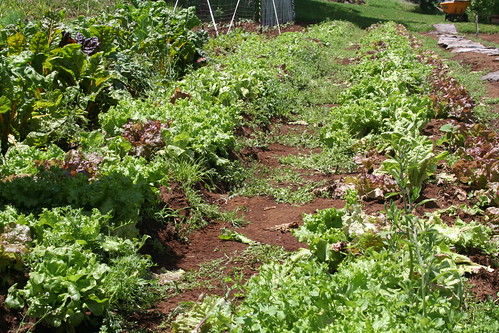


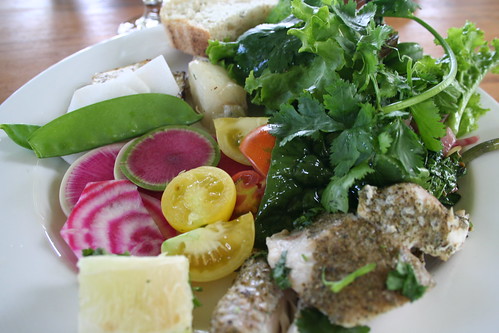
Coming soon in Maui, Part 3: The other end of the O'o Farm food chain, plus the stuff I couldn't neatly tie into Parts 1 or 2.
Hana Bay Juice Co.
111A Hana Highway
Paia, HI 96779
(808) 579-8686
Paia Fish Market
110 Hana Highway
Paia, HI 96779
(808) 579-8030
paiafishmarket.com
Ali'i Kula Lavender Farm
1100 Waipoli Road
Kula, HI 96790
(808) 878-3004
www.aliikulalavender.com
Surfing Goat Dairy
3651 Omaopio Road
Kula, HI 96790
(808) 878-2870
surfinggoatdairy.com
O'o Farm (reservation required)
Waipoli Road
Kula, HI 96790
(808) 667-4341
www.oofarm.com
